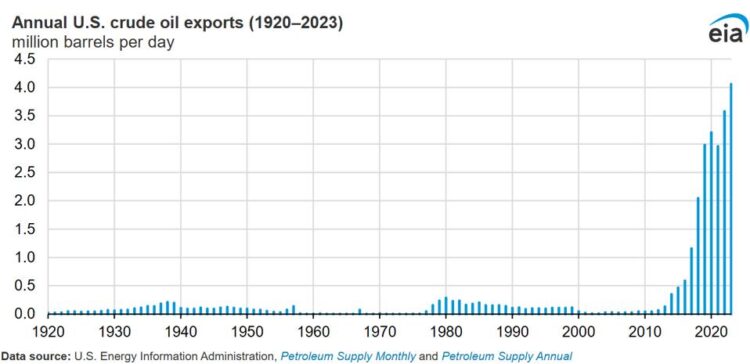
Fresh on the heels of a new U.S. oil production record and establishment of the U.S. as the world’s top liquefied natural gas (LNG) exporter, this week the Energy Information Administration reported that the U.S. exported a record amount of crude oil in 2023.The U.S. has exported small amounts of crude oil for over 100 years, despite being a net importer of crude oil. Although there was a crude oil export ban in place, some exports were allowed, primarily to Canada. That situation changed in the past decade.As the shale oil boom rapidly expanded U.S. oil production, domestic producers needed an outlet for the light, sweet crude oil that the boom was producing. U.S. refiners had a significant demand for crude oil, but they had spent decades investing billions of dollars into processing heavy, sour crude oil. They could process the new surge of crude oil being produced, but economically it made far more sense for them to buy the discounted heavy, sour crudes.This situation caused a glut for domestic oil producers, who wanted an end to the decades-long oil export ban. In December 2015 they got their wish when President Obama signed into law a $1.15 trillion spending bill that contained several energy provisions.The bill contained a provision “to promote the efficient exploration, production, storage, supply, marketing, pricing, and regulation of energy resources, including fossil fuels, no official of the Federal Government shall impose or enforce any restriction on the export of crude oil.”Exceptions to this rule are allowed in certain circumstances. The president can impose export licensing requirements for up to a year after declaring a national emergency, or if the secretary of commerce reports that crude oil exports are causing supply shortages or sustained premiums on domestic crude above global prices.Following the passage of the bill, oil exports immediately began to climb. From less than half a million barrels per day (BPD) in 2015, exports reached 1 million BPD in 2017, 2 million BPD in 2018, 3 million BPD in 2020, and 4 million BPD in 2023.  Annual U.S. Crude Oil Exports 1920-2023. ENERGY INFORMATION ADMINISTRATIONThe Netherlands was the top destination for U.S. oil exports in 2023, followed by China and South Korea. Since 2018, the primary regional destinations for U.S. crude oil exports have been Europe, Asia, and Oceania.In 2022, U.S. crude oil exports to Europe surged following Russia’s invasion of Ukraine and subsequent EU sanctions prohibiting seaborne crude oil imports from Russia. These sanctions propelled continued growth in U.S. exports to Europe in 2023. Notably, in 2023, U.S. crude oil exports to Europe averaged 1.8 BPD, slightly surpassing exports to Asia and Oceania, which stood at 1.7 million BPD.The net impact of continued U.S. export growth has been a steady decline in net crude oil imports. From 2004 through 2007, U.S. net crude oil imports averaged more than 10 million BPD. In 2023, that number was 2.4 million BPD, which was the lowest level since 1972.The journey from a history of minimal exports to becoming a prominent player in the global market underscores the nation’s evolving energy landscape. With robust legislation and changing market conditions, the U.S. has emerged as a significant contributor to international oil supply chains. As the country continues to navigate geopolitical and economic challenges, its role as a key exporter is poised to shape the future of global energy markets.More By This Author:Why Spring Means Higher Gas Prices
Annual U.S. Crude Oil Exports 1920-2023. ENERGY INFORMATION ADMINISTRATIONThe Netherlands was the top destination for U.S. oil exports in 2023, followed by China and South Korea. Since 2018, the primary regional destinations for U.S. crude oil exports have been Europe, Asia, and Oceania.In 2022, U.S. crude oil exports to Europe surged following Russia’s invasion of Ukraine and subsequent EU sanctions prohibiting seaborne crude oil imports from Russia. These sanctions propelled continued growth in U.S. exports to Europe in 2023. Notably, in 2023, U.S. crude oil exports to Europe averaged 1.8 BPD, slightly surpassing exports to Asia and Oceania, which stood at 1.7 million BPD.The net impact of continued U.S. export growth has been a steady decline in net crude oil imports. From 2004 through 2007, U.S. net crude oil imports averaged more than 10 million BPD. In 2023, that number was 2.4 million BPD, which was the lowest level since 1972.The journey from a history of minimal exports to becoming a prominent player in the global market underscores the nation’s evolving energy landscape. With robust legislation and changing market conditions, the U.S. has emerged as a significant contributor to international oil supply chains. As the country continues to navigate geopolitical and economic challenges, its role as a key exporter is poised to shape the future of global energy markets.More By This Author:Why Spring Means Higher Gas Prices
EIA Confirms U.S. Producing More Oil Than Any Country in History
State Of The Union: Biden Silent On Record Production
















